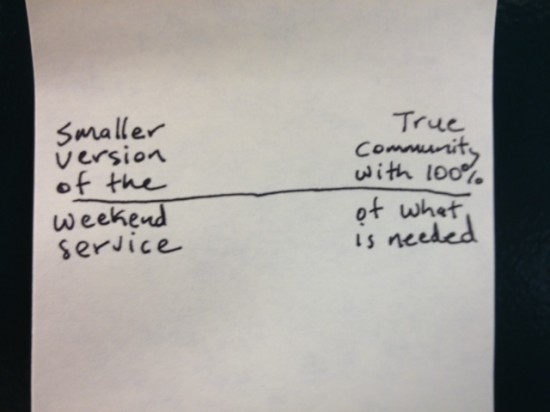True Community or Smaller Version of the Weekend Service?

Ever heard this one? “We want to be a church of groups. We’ve launched a decent number of off-campus groups, but we also have a number of on-campus Bible studies (Sunday School, ABFs, etc.). Our solution has been to call everything a group…even though what they’re actually experiencing is not the same. How do we help the on-campus ministries see the need to do anything different than they’ve always done?”
Can I share a simple tool you can use to paint the picture? I’ve often found that a simple drawing can be the beginning of a new understanding. You can see my simple drawing above. Here’s what it means:
For starters, we all know that there’s real value in the corporate worship service. Inspiring music. Dynamic teaching. Being together in the presence of God. All good. And an essential part of how people experience God.
At the same time, it is clear to most people that life-change happens most often where there is life-on-life interaction. As important as the corporate worship service is, they tend to be one-way communication. There’s no interaction…and that’s a key ingredient for life-change to happen. It’s difficult to feel known in a worship service. The one-anothers are hard to practice…in a worship service (See Life-Change at the Member Level and Sunday Worship = Defibrillator for more).
With me so far? This is the point where the drawing comes in.
True Community: A healthy small group, identified in the simple drawing as “true community,” ought to be a place where the one-anothers are practiced. Group members should experience what it is to belong. To feel cared for. To be prayed for. To be known. To be challenged and held accountable and loved and forgiven. True community.
Smaller version of the weekend service: Many of the classic on-campus groups (ABFs, adult Sunday School, etc.) are best described as smaller versions of the weekend service. Admittedly…not all of them, but many. They might sing a few songs. They often use a master teacher approach where the teacher teaches and the members listen. They have a prayer to begin and a prayer at the end. Sometimes, they even take an offering. If there is any interaction it is during a fellowship time (read: coffee and donuts) before and after the official program. Much like a worship service, only smaller.
I use the drawing to help identify where a group is along the continuum between “smaller version of the weekend service” and “true community.” A great exercise is to have the discussion with each of your on-campus groups and then begin to help them integrate elements of true community into their format. Problem-free? No. But it starts a conversation and movement.
Want do you think? Want to argue? Have a question? You can click here to jump into the conversation.


It is so true that smaller groups feed the sheep like no other collective. My wife and I have been leading a small group for almost 15 years. The structure hasn’t changed much over that time. We sing a few songs and then sit at a circle of tables. We look at a list of questions that arise out of a passage (usually from one of those little bible studies you can buy) Because we give opportunity for anyone to speak about what they see in the scripture as it pertains to the question, we usually get one question covered per meeting. (We once did a through-Romans-verse-by-verse and it took us two and a half years!). One of the things that I found valuable for the people is for me to bring tangential questions (instead of answers). After a time of prayer for issues brought up by anybody, we dismiss. Every so often, like between study chapters or whatever, we have a fellowship night where we just have fun.
Thanks for jumping in here! You’re on to a good thing. There is an element of true community that only works in smaller groups (or subgroups within a larger group).
mark